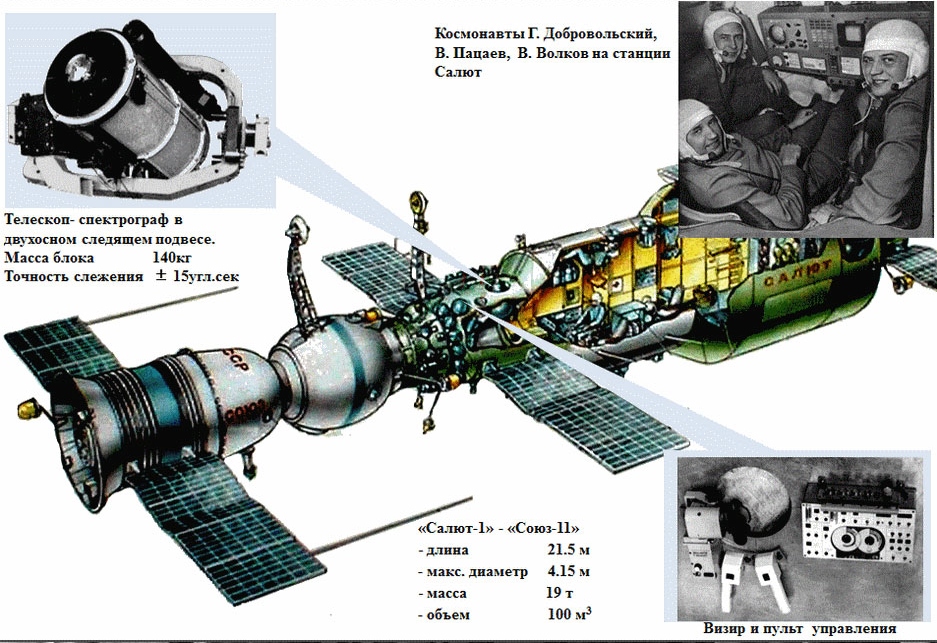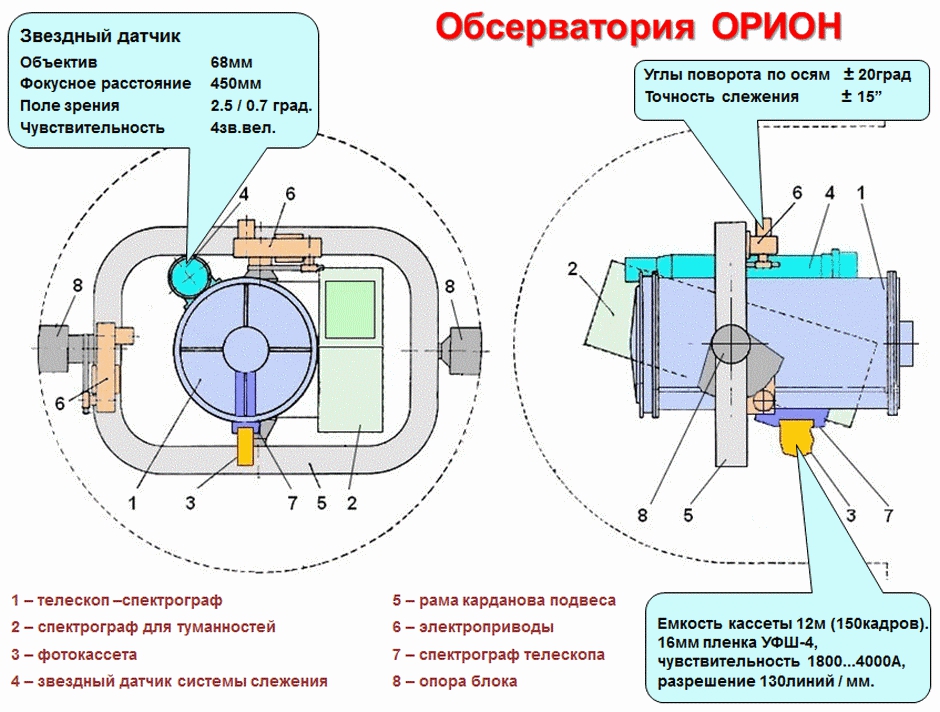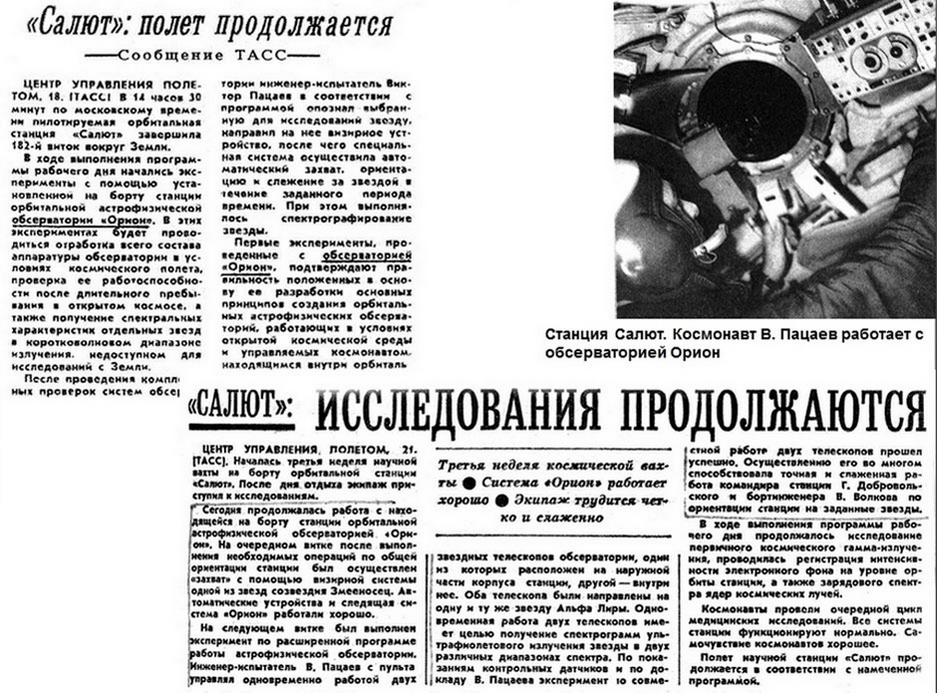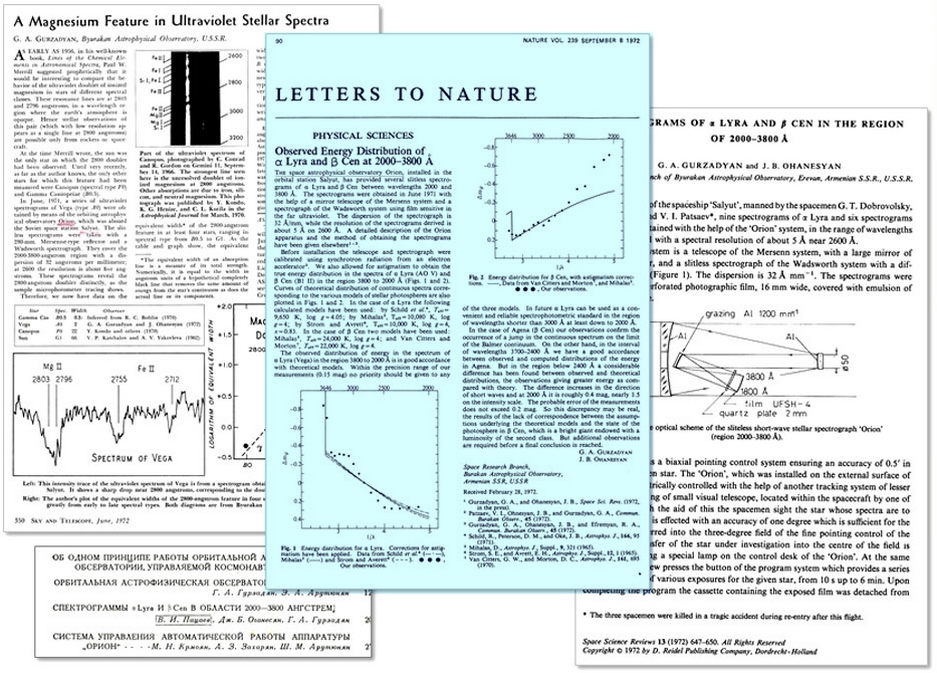(04/19/1971 – 10/11/1971)
Scientific supervisor – G. Gurzadyan
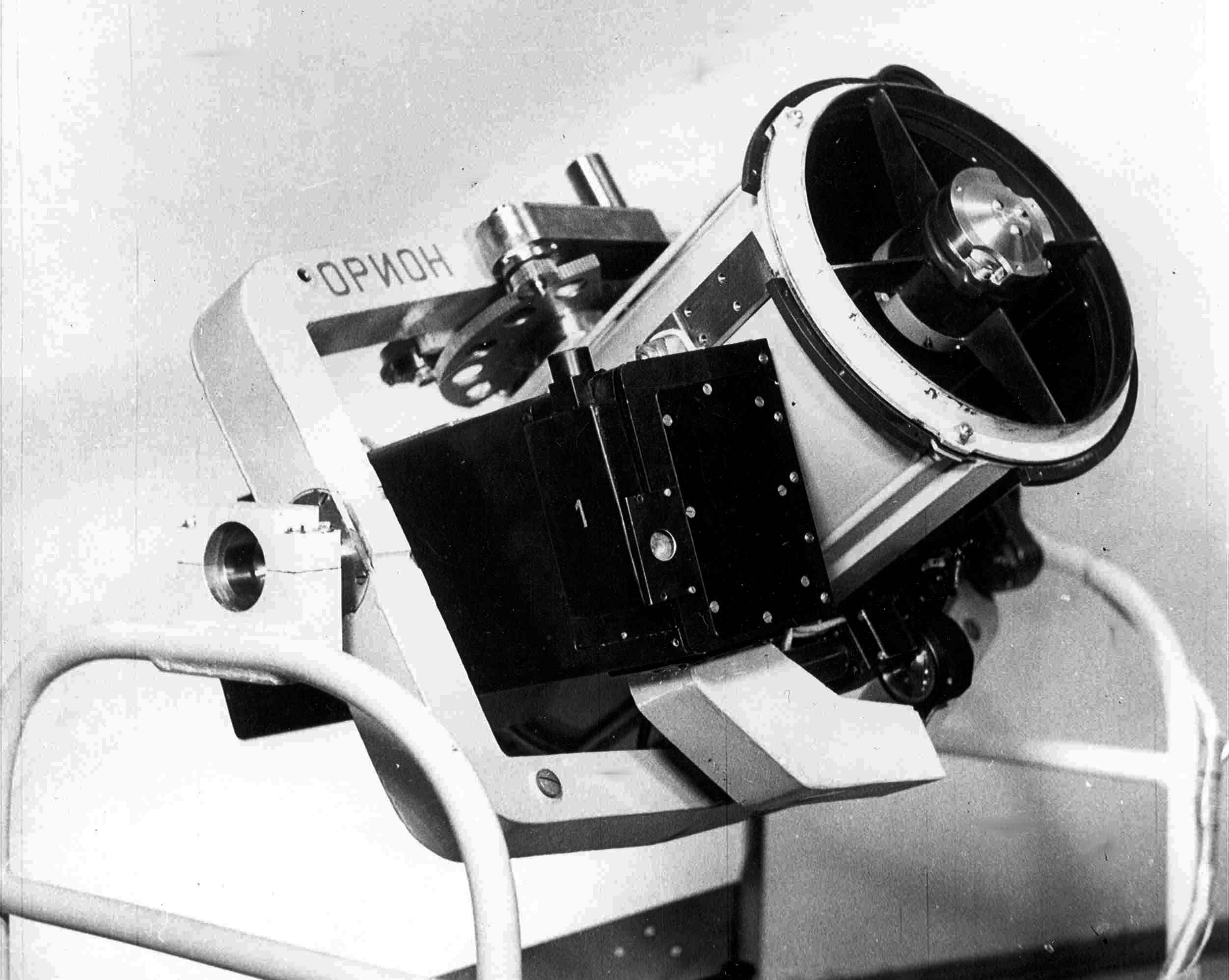 The ORION astrophysical observatory was launched into orbit on April 19, 1971 as part of the world’s first manned space station SALYUT.
The ORION astrophysical observatory was launched into orbit on April 19, 1971 as part of the world’s first manned space station SALYUT.
The first crew of the space station worked with the observatory: USSR cosmonauts Georgy Dobrovolsky, Vladislav Volkov and Viktor Patsaev, tragically died as a result of the accident of the transport ship SOYUZ-11 during descent from orbit.
The ORION-1 observatory was designed to obtain photographic spectrograms of stars up to the 5th magnitude in the UV spectral region 2000-3800 Å with a resolution of 5 Å (at a wavelength of 2600 Å).
The UV telescope-spectrograph with a star tracking sensor and other instruments was mounted in a biaxial gimbal and installed outside the station, in a special niche. In the same niche there was also a lock chamber for transporting photocassettes of instruments inside the station after the completion of the observation program.
Inside the station in front of a special quartz porthole, also in a biaxial tracking suspension, a second spectrograph of the observatory (also located on the tracking platform) was installed.
In front of another window, a sighting device was placed, with the help of which the astronaut remotely pointed the telescope at the star being studied. This device was a collimator sight mounted in a small biaxial suspension. The axes of this suspension and the corresponding axes of the gimbal suspensions of the telescope and internal spectrograph were connected by tracking systems using angular potentiometric sensors.
The control panel with the observatory electronics unit was also located inside the station. A Mersen system telescope with a light diameter of the main mirror (silica coated with aluminum) of 280 mm and a secondary mirror with a diameter of 50 mm with an effective focal length of 1400 mm was used in combination with a slitless spectrograph of the Wadsworth system.
The spectrograph used a concave diffraction grating with a curvature of 500 mm and a number of lines of 1200 per 1 mm. A quartz plane-parallel plate was installed in front of the film channel to cut off the second order of the spectrum shorter than 1900 A. The angular scale of the image was 2.5 arc minutes per 1 mm. Spectrograms were recorded on photographic film. There was a mechanism for expanding spectrograms to 0.4 mm.
Optical diagram of the ORION telescope-spectrograph
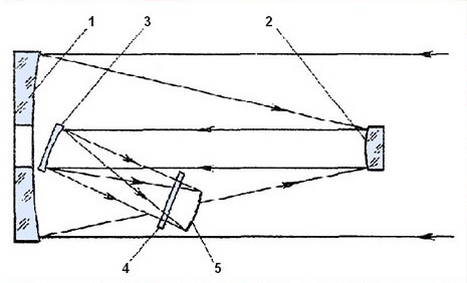 Mersen–Wadsward optical design.
Mersen–Wadsward optical design.
1 — main mirror D = 280mm
2 — secondary mirror d = 50mm
3 — diffraction grating 55 x 50mm (1200 lines/mm)
4 — light filter
5 — movie channel
The order of the experiment was as follows:
- In the shadow part of the orbit (lasting up to 30 minutes), the cosmonaut, using the control buttons on the sighting device, aimed the crosshair of the collimator sight at a given star under study.
- After that, he turned on the tracking system, the result of which was the coordination of the corresponding axes of the gimbal with an accuracy of approximately ±10 arc.min. At the same time, the star under study fell into the field of view of the star sensor and the tracking system automatically switched to autonomous guiding mode based on signals from the star sensor.
- In stabilization mode, the astronaut carried out the exposure program.
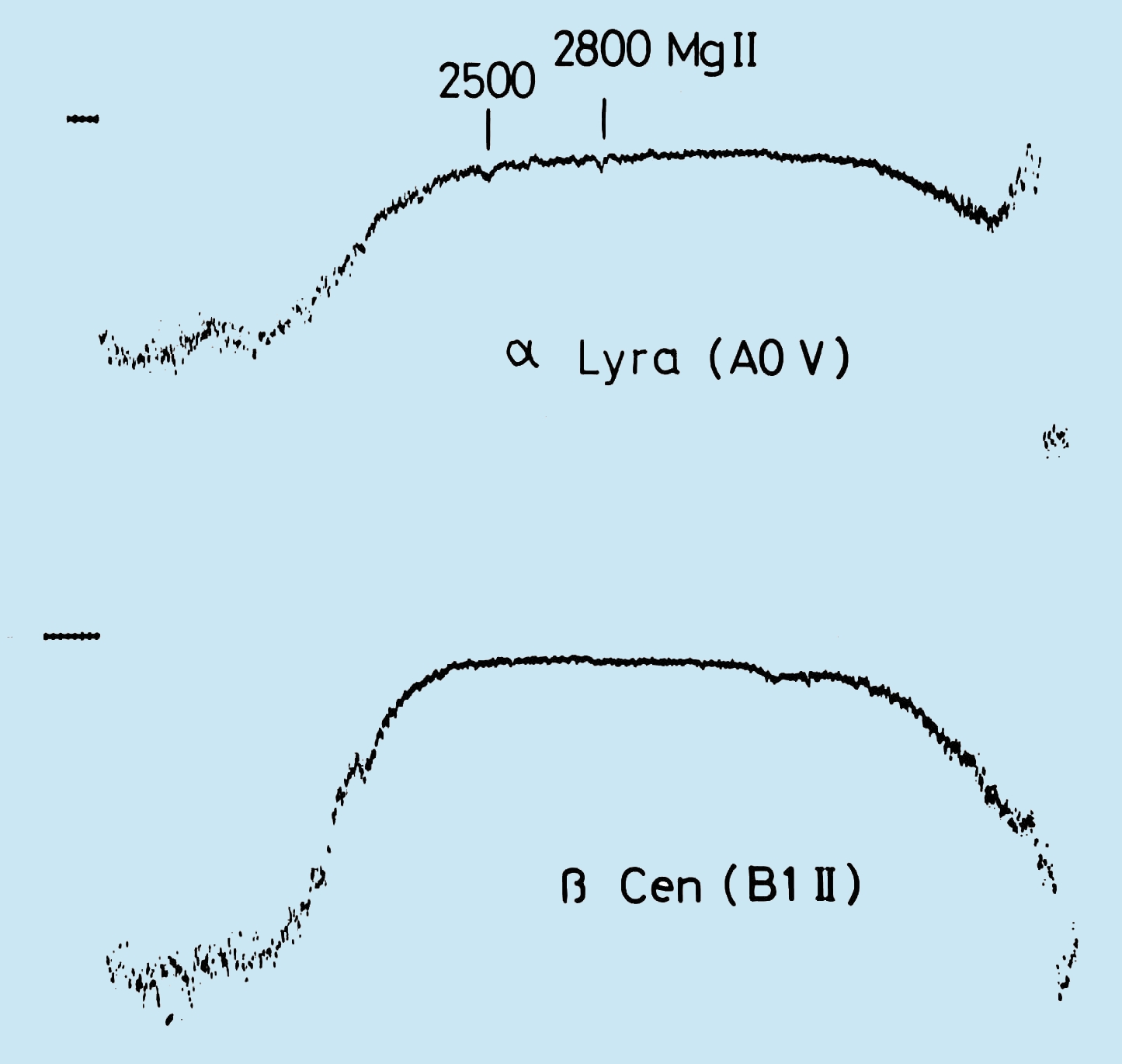 Results obtained by the ORION observatory
Results obtained by the ORION observatory
06/18/1971 – 6 spectrograms β Cen (Agena, 0.69 mag.)
06/21/1971 – 9 spectrograms of α Lyra (Vega, 0.05 mag.)
These are the world’s first ultraviolet spectrograms of stars obtained on board manned spacecraft. Viktor Patsaev is the first person to directly perform astronomical observations outside the atmosphere.
Before the launch of the Orion-1 observatory, taking advantage of the fact that an electron accelerator was launched at the Physics Institute in Yerevan, it was decided to try to implement the idea of using synchrotron radiation for the theoretical calibration of astronomical equipment. After negotiations with the leaders of the Physics Institute, an agreement was reached on the creation of such a special installation for the extraction of synchrotron radiation from the accelerator and its disposal in a special chamber, and at the end of 1970, through joint efforts, such an installation was created and the Orion-1 telescope was successfully calibrated on it.
Publications
- G.A.Gurzadyan. A Magnesium Feature in Ultraviolet Stellar Spectra, Sky & Telescope, vol.43, p.350, 1972.
- G.A.Gurzadyan., J.B.Ohanesyan. Observed Energy Distribution of alpha LYRA and beta CEN at 2000-3800 A. Nature, 239, 90, 1972.
- G.A.Gurzadyan and J.B.Ohanesyan. Spectrograms of alpha Lyra and beta Cen in the region of 2000-3800 A. Space Science Reviews, 13, 647, 1972.
- G.A.Gurzadyan. Highlighting a Mode of Operation of the Orbital Astronomical Observatory Manned by a Cosmonaut. Comm. Byurakan Obs., 45, 5, 1972.
- G.A.Gurzadyan, E.A.Harutyunian. The Orbital Astrophysical Observatory ORION. Comm. Byurakan Obs., 45, 12, 1972.
- V.I.Patsaev, J.B.Ohanesyan, G.A.Gurzadyan. Spectrograms of alpha LYRA and beta CEN in the Range of 2000 – 3800 A. Comm. Byurakan Obs., 45, 20, 1972.
- M.N.Krmoyan, A.Z.Zakharyan, Sh.M.Harutyunyan. The Control System of the Automatic Operation of the ORION Equipment. Comm. Byurakan Obs., 45, 27, 1972.
- G.A.Gurzadyan, J.B.Ohanesyan, P.A.Yephremyan. Energy Calibration of the ORION Spectrograph. Comm. Byurakan Obs., 45, 36, 1972.
- V.M.Uvarova, M.P.Shpolskiy, A.N.Oshurkova, J.B.Ohanesyan, M.V.Uvarova. An Investigation of the Photographic Characteristics of the Film UFSH-4 Used in the ORION Equipment. Comm. Byurakan Obs., 45, 42, 1972.
- G.A.Gurzadyan and J.B.Ohanesyan. Ultraviolet Absorption Lines in the Spectrum of Vega. Astron. & Astrophys., 20, 321, 1972.
- G.A.Gurzadyan and J.B.Ohanesyan. Energy Distribution in the Continuous Spectrum of Vega and Agena in the Region of 2000 – 3800 A. Astrofizika, 9, 197, 1973.
Last Updated on 2025.01.09
